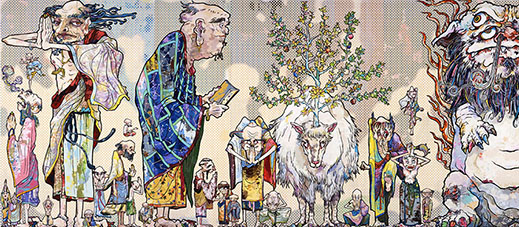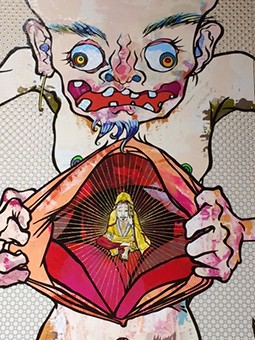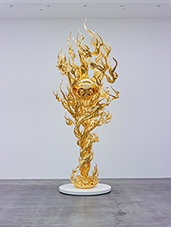 |
Focus features two in-depth reviews each month of fine art, architecture and design exhibitions and events at art museums, galleries and alternative spaces around Japan. The contributors are non-Japanese art critics living in Japan. |
|
|
 |
 |
 |
Murakami's Unforgettable 500
Lucy Birmingham |
 |
Takashi Murakami at a photo session, 2015. Photo by Lucy Birmingham |
|
Takashi Murakami at a press conference, 2015. Photo by Lucy Birmingham |
Takashi Murakami's rise to fame and fortune as one of the world's most influential contemporary artists has been a bittersweet ride. Praise and criticism have followed him throughout. Praise, for boldly combining Japanese manga, anime, subculture and kawaii themes in shocking, satirical and skillfully executed paintings and sculptures. Criticism, for his astronomical art-market prices, shameless commercialization, and factory-style production methods.
Murakami claims he doesn't mind the dissing. He says he's not creating art for today, but wants his work to be relevant in 100 or 200 years' time. Like Warhol, once he's dead people will understand what he was about.
Love him or hate him, dead or alive, one thing's for sure: Murakami puts on an unforgettable show. Highlights include his 2007-2009 traveling retrospective with a Louis Vuitton boutique as part of the exhibition, selling his commissioned handbags. His show at the Palace of Versailles in 2010 attracted loud protest from thousands of French traditionalists, along with welcome international media attention.
 |
|
 |
|
|
|
The 500 Arhats (detail), 2012; acrylic on canvas, mounted on board, 302 x 10,000 cm; private collection. © 2012 Takashi Murakami / Kaikai Kiki Co., Ltd. All Rights Reserved. |
|
Takashi Murakami, Enso: At Our Side, 2015; acrylic, gold leaf and platinum leaf on canvas mounted on aluminum frame, 170 x 144.7 cm. © 2015 Takashi Murakami / Kaikai Kiki Co., Ltd. All Rights Reserved. |
His exhibition Takahashi Murakami: The 500 Arhats, at the Mori Art Museum until March 6, 2016, is his first major show in Japan in 14 years. A monumental effort three meters tall and 100 meters wide, the titular painting is being called the largest in history.
The definition of an arhat varies depending on the school of Buddhism. Some identify the arhats as Buddha's earliest, most dedicated disciples, who gathered around 543 BCE to preserve their master's teachings soon after his passing. Others liken them to Christian saints or sages who used their powers to help those in distress. "The 500 Arhats" is said to be a story about healing 500 varieties of human suffering.
Murakami's massive painting was originally created for an exhibition in 2012 in Dohar with financial backing. "I didn't know how much it would cost to make such a large work," says Murakami during a Mori Art Museum talk about the exhibition. "All my sponsors are overseas. Some consider it a social contribution. Some are arms dealers, so I can't say it's all clean money."
 |
|
|
|
The 500 Arhats (detail), 2012; acrylic on canvas, mounted on board, 302 x 10,000 cm; private collection. © 2012 Takashi Murakami / Kaikai Kiki Co., Ltd. All Rights Reserved. |
With assistance from over 200 students at Japanese art colleges and Murakami's Kaikai Kiki art factory staff, the painting was finished in only about eight months. Compare this with the ten years it took Kano Kazunobu (1816-63) to paint his epic version of the 500 Arhats and you get a sense of Murakami's astounding efficiency, drive, and innovative production methods.
Kano Kazunobu was driven by the great disasters and political turmoil of his time, when many of the afflicted turned to religion for salvation. Murakami says it was the suffering unleashed by the 2011 Tohoku earthquake and tsunami that moved him to create his version.
He clearly states that he's not religious, but admits his feelings have shifted. "Before the quake I thought religion was evil and directing people in the wrong way," he says. "My parents went to Soka Gakkai events when I was young, and I thought that was very weird. But after the quake, I began to understand why human beings want to seek something unknown and go towards religion."
 |
|
 |
|
Two details from The 500 Arhats, 2012; acrylic on canvas, mounted on board, 302 x 10,000 cm; private collection. Photos by Lucy Birmingham |
Murakami also mentions his post-2011 thematic conversion. "Before the earthquake I made my base in New York and London. Capitalism was the theme of the nineties and I thought I was participating in that movement. But after the quake I realized I was just pretending to be a part of an art movement. It was a time for me to reflect on where I was. ‘What is the truth?' I began to dig into that more."
Stylistically, Kazunobu and Murakami's versions could not be more different. Kazunobu's 100 hanging scrolls include shadowy, frightening images of hell, fiery dragons and all-purpose horror reminiscent of the "Hell Scrolls" of the Heian period (794-1185). Murakami, on the other hand, has employed his famous "Superflat" mangaesque forms with his signature vivid colors, which one viewer at the exhibition said reminded him of Disneyland. If you're interested in comparing the two, you're in luck. Tokyo's Zojoji temple, not far from the Mori, is exhibiting a portion of Kazunobu's 500 Arhats more or less concurrently with the Murakami show.
 |
|
 |
|
Takashi Murakami, Flame of Desire - Gold, 2013; gold leaf on carbon fiber, 498.4 x 188.6 x 183.1 cm; courtesy of Blum & Poe, Los Angeles. © 2013 Takashi Murakami / Kaikai Kiki Co., Ltd. All Rights Reserved. |
|
Takashi Murakami, Daruma the Great, 2007; acrylic and platinum leaf on canvas mounted on board; private collection; courtesy of Galerie Perrotin. Photo by Lucy Birmingham |
But while Kazunobu and the 2011 quake may have provided inspiration for Murakami's 500 Arhats, the seeds were sown during an exchange with art historian Nobuo Tsuji between 2009 and 2011. The two collaborated on a series of "installments" in the art magazine Geijutsu Shincho titled Nippon E-awase (Japan Picture Contest), based on a game played by the nobility in the Heian period. Tsuji challenged Murakami to paint again.
The exhibition also includes some of Murakami's large-scale sculptures, well-known paintings, and new works shown in Japan for the first time. The special-effects photo titled Reborn, placed next to three paintings parodying art critics, is disturbing and entertaining: the Murakami paradox.
Murakami says he's inspired by Japanese culture and wants to have a conversation with the Japanese about his work. He found, though, that this was impossible with his contemporary artworks. "I've felt it was a waste of time to do an exhibition in Japan," he says. But he discovered instead that his films and videos resonate with Japanese audiences these days. His first live-action feature film Jellyfish Eyes was released in 2013, and his animated television series 6HP (Six Hearts Princess) is scheduled for release in 2016.
In 100 to 200 years, will the prolific art provocateur be remembered as a mercurial genius with a knack for commercial success, or simply as an enigma? Safe to say he won't mind the dissing. He'll never know.
 |
|
Takashi Murakami, Reborn, 2012; pigment print. Photographer: Hideo Kentaro; stylist: Yunoki Kazuki; special effects makeup: JIRO; production coordinator: Kaikai Kiki. Photo by Lucy Birmingham |
 |
 |
Lucy Birmingham
Lucy Birmingham is a long-time, Tokyo-based journalist, scriptwriter, author, and former photojournalist. She recently served two years as president of the Foreign Correspondents' Club of Japan. She has written regularly for TIME magazine and her articles have appeared in many publications, including the Wall Street Journal, Newsweek, Bloomberg News, and Architectural Digest. As an arts and culture writer her articles have appeared in publications including Artinfo.com, Artforum.com, and ARTnews. She is also a scriptwriter and narrator for NHK (Japan's public broadcaster) and has published several books including Strong in the Rain: Surviving Japan's Earthquake, Tsunami, and Fukushima Nuclear Disaster.
lucybirmingham.com |
|
 |
|